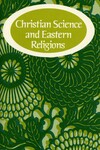

Are you sure?
This bookmark will be removed from all folders and any saved notes will be permanently removed.
Meditation and Mao
A young man, garbed in a bright tunic of orange silk, sat in the classic lotus posture of meditation, eyes closed. The room, filled with the heavy scent of burning incense, was dimly lighted by two large candles. Slowly, almost reluctantly, the young man—a graduate student at one of the well-known universities in the United States and an American—opened his eyes. With ceremonial dignity he lifted his tunic over his head and placed it on the floor.
Breast bare now, he lighted a torch, solemnly applied the flames to his chest, face, eyes, hair. He was not burned. Like Shadrach, Meshach, and Abed-nego, he had not even "the smell of fire" Dan. 3:27; on him.
This dramatic incident was the highlight of a Buddhist marriage ceremony performed in San Francisco recently. Both bride and bridegroom were Caucasian, not Oriental. Both came from prominent West Coast families; both were highly intelligent and idealistic young Americans. The episode illustrates an increasing phenomenon of American campus life—the turning away from Christian orthodoxy and the seeking of solace in Oriental religion. "Meditation and Mao" someone called this growing trend, though the two are, of course, antithetical since dialectical materialism, even as interpreted by Chairman Mao, leaves no room for such spiritual values as are embraced by Buddhist or Vedic mysticism. The campuses, shaken by the violence of the new left, are at least as entranced by Hindu gurus and Buddhist Zen masters. Even calisthenics yields to karate. Why? What is this all about?
Enjoy 1 free Sentinel article or audio program each month, including content from 1898 to today.
JSH Collections
This article is included in:
1972 - PAMPHLET
Christian Science and eastern religions
This article is included in:
1970 - SPECIAL PRINT ISSUE
1970 - Special Issue
JSH-Online has hundreds of pamphlets, anthologies, and special editions for you to discover.

November 7, 1970 issue
View Issue-
Meditation and Mao
HOWARD PALFREY JONES
-
Role Playing
GEORGE ELDREDGE HAMLIN, JR.
-
The Turning Point in My Life
ROSALYN B. MILLER
-
Sex and the Christian Scientist
GODFREY JOHN
-
UNBROKEN BEING
Peter J. Henniker-Heaton
-
WHEREVER YOU ARE, BE
Stephen Ellis Clizbe
-
An Interview: what parents can do right
with contributions from Philadelphia Shideler, Kenneth McKelvie
-
ALL THINGS NEW
Jessie Louise Salls
-
Heaven Comes Gently
Naomi Price
-
Love Heals Alienation
Alan A. Aylwin
-
Our children are fourth generation Christian Scientists, and the...
Lona Belle Ingwerson with contributions from Donald W. Ingwerson
-
When I was in the third grade, my family took up the study of...
Vernon C. Weston
-
Once again I have found that Christian Science, the Science of
Jean-Pierre Abel
-
I had the privilege of being raised in a home where Christian Science...
Janeve Warren Whalley with contributions from David L. Whalley
-
I grew up in Christian Science with the comforting assurance...
Cheryl Henderson
-
Signs of the Times
Tom Boomershine



